User login
WASHINGTON – Despite the recent attention given to considering obesity a disease, there are still many limitations to providing treatments for obesity and receiving adequate reimbursement for those treatments, Dr. Lee Kaplan said at a public workshop cosponsored by the Food and Drug Administration and the American Gastroenterological Association.
The American Medical Association resolution to recognize obesity as a disease in 2013 has no legal authority, and therefore does not represent as much progress as suggested by the media attention surrounding the announcement, said Dr. Kaplan, director of the Massachusetts General Hospital Weight Center, Boston.
The AMA resolution was preceded by the Internal Revenue Service’s determination that obesity could qualify as a medical deduction in 2007, and in 2008, the Obesity Society provided support for considering obesity as a medical disorder.
But despite these apparent signs of progress, limitations remain. Weight loss drugs are excluded under Medicare Part D coverage, and while Medicare has started coverage for nutritional counseling, only services provided in a primary care setting are covered, he pointed out. An estimated 1 of every 400 people with obesity in the United States has bariatric surgery every year, but 1 in 100-150 of every 400 meets the criteria for surgery, which "doesn’t sound like we are addressing the problem very seriously," he said.
One problem is that obesity, which has many causes, is lumped together "into one big group," raising the issue of whether treating obesity would require an investment that is so huge, "that even as a society we cannot make it."
A critical issue is how to define obesity, Dr. Kaplan said. A simple definition is excess fat accumulation that presents a risk to health, but this definition does not include ways of measuring excess fat. One measurement, body mass index, is a marker, not a definition of obesity.
A major barrier is the development of an effective therapy, he said, noting that other than gastric bands, there are no devices on the market to treat obesity, and the four drugs approved by the FDA have modest efficacy overall and are not widely used. Another major barrier is "provider utilization," getting the provider to prescribe treatments and obtain reimbursement for the costs of treatment.
"There is also a large gap between the relatively noninvasive treatments and the invasive, more effective therapies, which needs to be filled by midlevel therapies," he said. Those therapies should be gastrointestinal therapies almost exclusively, he added. The current treatment strategy is fairly simplistic: Patients are asked to change their lifestyle and when that does not work, the next step is to see a dietician, psychologist, or another professional to help with their lifestyle changes, followed by the addition of medication if that does not work. Surgery is broached in a small number of patients.
"Obesity is a disease whether we call it one or not, because it behaves like a disease," and there are implications to viewing it as a disease, he said. Therapy should be physiologically based, and the heterogeneity in the underlying causes of obesity, which explains the variable treatment responses, provides an opportunity to benefit selected subpopulations.
Considering the number of disorders that are associated with obesity, it is not surprising that treatment responses vary widely, Dr. Kaplan said. People with one defect may do better than others with gastric bypass, and some people may respond better than others to the approved combination of phentermine and topiramate (Qsymia) – as reflected in the ranges of response rates associated with these therapies, he pointed out.
The average excess weight loss with gastric bypass, the most effective therapy for obesity, is about 65%, but it can be as low as 20% in some people. With banding, some patients lose all or most of their excess weight, but most lose about 25%-30%, he said. Similarly, Dr. Kaplan found some patients responded well to treatment with sibutramine (which is no longer marketed), while others did not respond well; the same pattern was seen with lorcaserin.
"Whether you’re talking about a drug, a device, surgery, or lifestyle modifications, ... you see this very broad response," because there are subtypes of obesity, he said. Identifying the subgroups of patients that are highly responsive to any of these treatments could increase the success rate of the treatment, he noted.
In December 2013, the AGA's Center for Gastrointestinal Innovation and Technology (CGIT), along with the Food and Drug Administration, held a workshop on "Changing Regulatory and Reimbursement Paradigms for Medical Devices in the Treatment of Metabolic Diseases: How to Estimate and Reward True Patient-Centric Value."

|
| Dr. Jay Pasricha |
The theme of the workshop was broad, but obesity and reflux were chosen as representative conditions that highlighted the challenges that companies and innovators face. The FDA showcased some truly innovative GI devices. These initiatives were praised by the other groups, and it is hoped the workshop will inspire similar introspection into coverage policies as well.
It also became clear at the workshop that continuing with current regulatory and reimbursement procedures may result in the throttling of medical innovation. Therefore, taking ownership of the reform process is a task that all parties need to embrace.
The workshop was very successful in bringing together representatives from all walks, and members in the audience enthusiastically joined vigorous discussions by the panel. As a follow-up, the CGIT and FDA are working on a white paper that will lay out a road map for much needed changes.
Dr. Jay Pasricha is director of the Center for Neurogastroenterology and professor (PAR) of medicine at Johns Hopkins University, Baltimore. He has no relevant conflicts of interest.
In December 2013, the AGA's Center for Gastrointestinal Innovation and Technology (CGIT), along with the Food and Drug Administration, held a workshop on "Changing Regulatory and Reimbursement Paradigms for Medical Devices in the Treatment of Metabolic Diseases: How to Estimate and Reward True Patient-Centric Value."

|
| Dr. Jay Pasricha |
The theme of the workshop was broad, but obesity and reflux were chosen as representative conditions that highlighted the challenges that companies and innovators face. The FDA showcased some truly innovative GI devices. These initiatives were praised by the other groups, and it is hoped the workshop will inspire similar introspection into coverage policies as well.
It also became clear at the workshop that continuing with current regulatory and reimbursement procedures may result in the throttling of medical innovation. Therefore, taking ownership of the reform process is a task that all parties need to embrace.
The workshop was very successful in bringing together representatives from all walks, and members in the audience enthusiastically joined vigorous discussions by the panel. As a follow-up, the CGIT and FDA are working on a white paper that will lay out a road map for much needed changes.
Dr. Jay Pasricha is director of the Center for Neurogastroenterology and professor (PAR) of medicine at Johns Hopkins University, Baltimore. He has no relevant conflicts of interest.
In December 2013, the AGA's Center for Gastrointestinal Innovation and Technology (CGIT), along with the Food and Drug Administration, held a workshop on "Changing Regulatory and Reimbursement Paradigms for Medical Devices in the Treatment of Metabolic Diseases: How to Estimate and Reward True Patient-Centric Value."

|
| Dr. Jay Pasricha |
The theme of the workshop was broad, but obesity and reflux were chosen as representative conditions that highlighted the challenges that companies and innovators face. The FDA showcased some truly innovative GI devices. These initiatives were praised by the other groups, and it is hoped the workshop will inspire similar introspection into coverage policies as well.
It also became clear at the workshop that continuing with current regulatory and reimbursement procedures may result in the throttling of medical innovation. Therefore, taking ownership of the reform process is a task that all parties need to embrace.
The workshop was very successful in bringing together representatives from all walks, and members in the audience enthusiastically joined vigorous discussions by the panel. As a follow-up, the CGIT and FDA are working on a white paper that will lay out a road map for much needed changes.
Dr. Jay Pasricha is director of the Center for Neurogastroenterology and professor (PAR) of medicine at Johns Hopkins University, Baltimore. He has no relevant conflicts of interest.
WASHINGTON – Despite the recent attention given to considering obesity a disease, there are still many limitations to providing treatments for obesity and receiving adequate reimbursement for those treatments, Dr. Lee Kaplan said at a public workshop cosponsored by the Food and Drug Administration and the American Gastroenterological Association.
The American Medical Association resolution to recognize obesity as a disease in 2013 has no legal authority, and therefore does not represent as much progress as suggested by the media attention surrounding the announcement, said Dr. Kaplan, director of the Massachusetts General Hospital Weight Center, Boston.
The AMA resolution was preceded by the Internal Revenue Service’s determination that obesity could qualify as a medical deduction in 2007, and in 2008, the Obesity Society provided support for considering obesity as a medical disorder.
But despite these apparent signs of progress, limitations remain. Weight loss drugs are excluded under Medicare Part D coverage, and while Medicare has started coverage for nutritional counseling, only services provided in a primary care setting are covered, he pointed out. An estimated 1 of every 400 people with obesity in the United States has bariatric surgery every year, but 1 in 100-150 of every 400 meets the criteria for surgery, which "doesn’t sound like we are addressing the problem very seriously," he said.
One problem is that obesity, which has many causes, is lumped together "into one big group," raising the issue of whether treating obesity would require an investment that is so huge, "that even as a society we cannot make it."
A critical issue is how to define obesity, Dr. Kaplan said. A simple definition is excess fat accumulation that presents a risk to health, but this definition does not include ways of measuring excess fat. One measurement, body mass index, is a marker, not a definition of obesity.
A major barrier is the development of an effective therapy, he said, noting that other than gastric bands, there are no devices on the market to treat obesity, and the four drugs approved by the FDA have modest efficacy overall and are not widely used. Another major barrier is "provider utilization," getting the provider to prescribe treatments and obtain reimbursement for the costs of treatment.
"There is also a large gap between the relatively noninvasive treatments and the invasive, more effective therapies, which needs to be filled by midlevel therapies," he said. Those therapies should be gastrointestinal therapies almost exclusively, he added. The current treatment strategy is fairly simplistic: Patients are asked to change their lifestyle and when that does not work, the next step is to see a dietician, psychologist, or another professional to help with their lifestyle changes, followed by the addition of medication if that does not work. Surgery is broached in a small number of patients.
"Obesity is a disease whether we call it one or not, because it behaves like a disease," and there are implications to viewing it as a disease, he said. Therapy should be physiologically based, and the heterogeneity in the underlying causes of obesity, which explains the variable treatment responses, provides an opportunity to benefit selected subpopulations.
Considering the number of disorders that are associated with obesity, it is not surprising that treatment responses vary widely, Dr. Kaplan said. People with one defect may do better than others with gastric bypass, and some people may respond better than others to the approved combination of phentermine and topiramate (Qsymia) – as reflected in the ranges of response rates associated with these therapies, he pointed out.
The average excess weight loss with gastric bypass, the most effective therapy for obesity, is about 65%, but it can be as low as 20% in some people. With banding, some patients lose all or most of their excess weight, but most lose about 25%-30%, he said. Similarly, Dr. Kaplan found some patients responded well to treatment with sibutramine (which is no longer marketed), while others did not respond well; the same pattern was seen with lorcaserin.
"Whether you’re talking about a drug, a device, surgery, or lifestyle modifications, ... you see this very broad response," because there are subtypes of obesity, he said. Identifying the subgroups of patients that are highly responsive to any of these treatments could increase the success rate of the treatment, he noted.
WASHINGTON – Despite the recent attention given to considering obesity a disease, there are still many limitations to providing treatments for obesity and receiving adequate reimbursement for those treatments, Dr. Lee Kaplan said at a public workshop cosponsored by the Food and Drug Administration and the American Gastroenterological Association.
The American Medical Association resolution to recognize obesity as a disease in 2013 has no legal authority, and therefore does not represent as much progress as suggested by the media attention surrounding the announcement, said Dr. Kaplan, director of the Massachusetts General Hospital Weight Center, Boston.
The AMA resolution was preceded by the Internal Revenue Service’s determination that obesity could qualify as a medical deduction in 2007, and in 2008, the Obesity Society provided support for considering obesity as a medical disorder.
But despite these apparent signs of progress, limitations remain. Weight loss drugs are excluded under Medicare Part D coverage, and while Medicare has started coverage for nutritional counseling, only services provided in a primary care setting are covered, he pointed out. An estimated 1 of every 400 people with obesity in the United States has bariatric surgery every year, but 1 in 100-150 of every 400 meets the criteria for surgery, which "doesn’t sound like we are addressing the problem very seriously," he said.
One problem is that obesity, which has many causes, is lumped together "into one big group," raising the issue of whether treating obesity would require an investment that is so huge, "that even as a society we cannot make it."
A critical issue is how to define obesity, Dr. Kaplan said. A simple definition is excess fat accumulation that presents a risk to health, but this definition does not include ways of measuring excess fat. One measurement, body mass index, is a marker, not a definition of obesity.
A major barrier is the development of an effective therapy, he said, noting that other than gastric bands, there are no devices on the market to treat obesity, and the four drugs approved by the FDA have modest efficacy overall and are not widely used. Another major barrier is "provider utilization," getting the provider to prescribe treatments and obtain reimbursement for the costs of treatment.
"There is also a large gap between the relatively noninvasive treatments and the invasive, more effective therapies, which needs to be filled by midlevel therapies," he said. Those therapies should be gastrointestinal therapies almost exclusively, he added. The current treatment strategy is fairly simplistic: Patients are asked to change their lifestyle and when that does not work, the next step is to see a dietician, psychologist, or another professional to help with their lifestyle changes, followed by the addition of medication if that does not work. Surgery is broached in a small number of patients.
"Obesity is a disease whether we call it one or not, because it behaves like a disease," and there are implications to viewing it as a disease, he said. Therapy should be physiologically based, and the heterogeneity in the underlying causes of obesity, which explains the variable treatment responses, provides an opportunity to benefit selected subpopulations.
Considering the number of disorders that are associated with obesity, it is not surprising that treatment responses vary widely, Dr. Kaplan said. People with one defect may do better than others with gastric bypass, and some people may respond better than others to the approved combination of phentermine and topiramate (Qsymia) – as reflected in the ranges of response rates associated with these therapies, he pointed out.
The average excess weight loss with gastric bypass, the most effective therapy for obesity, is about 65%, but it can be as low as 20% in some people. With banding, some patients lose all or most of their excess weight, but most lose about 25%-30%, he said. Similarly, Dr. Kaplan found some patients responded well to treatment with sibutramine (which is no longer marketed), while others did not respond well; the same pattern was seen with lorcaserin.
"Whether you’re talking about a drug, a device, surgery, or lifestyle modifications, ... you see this very broad response," because there are subtypes of obesity, he said. Identifying the subgroups of patients that are highly responsive to any of these treatments could increase the success rate of the treatment, he noted.
AT AN FDA/AGA WORKSHOP

